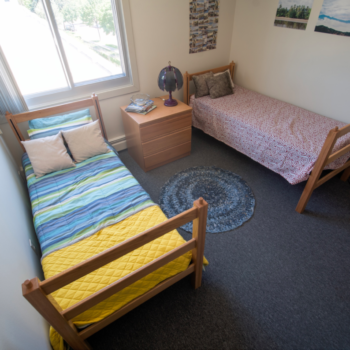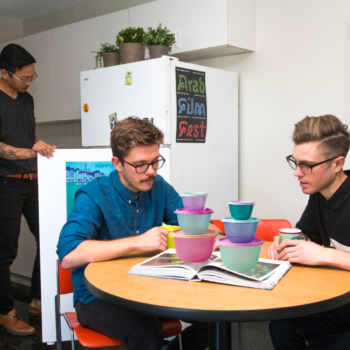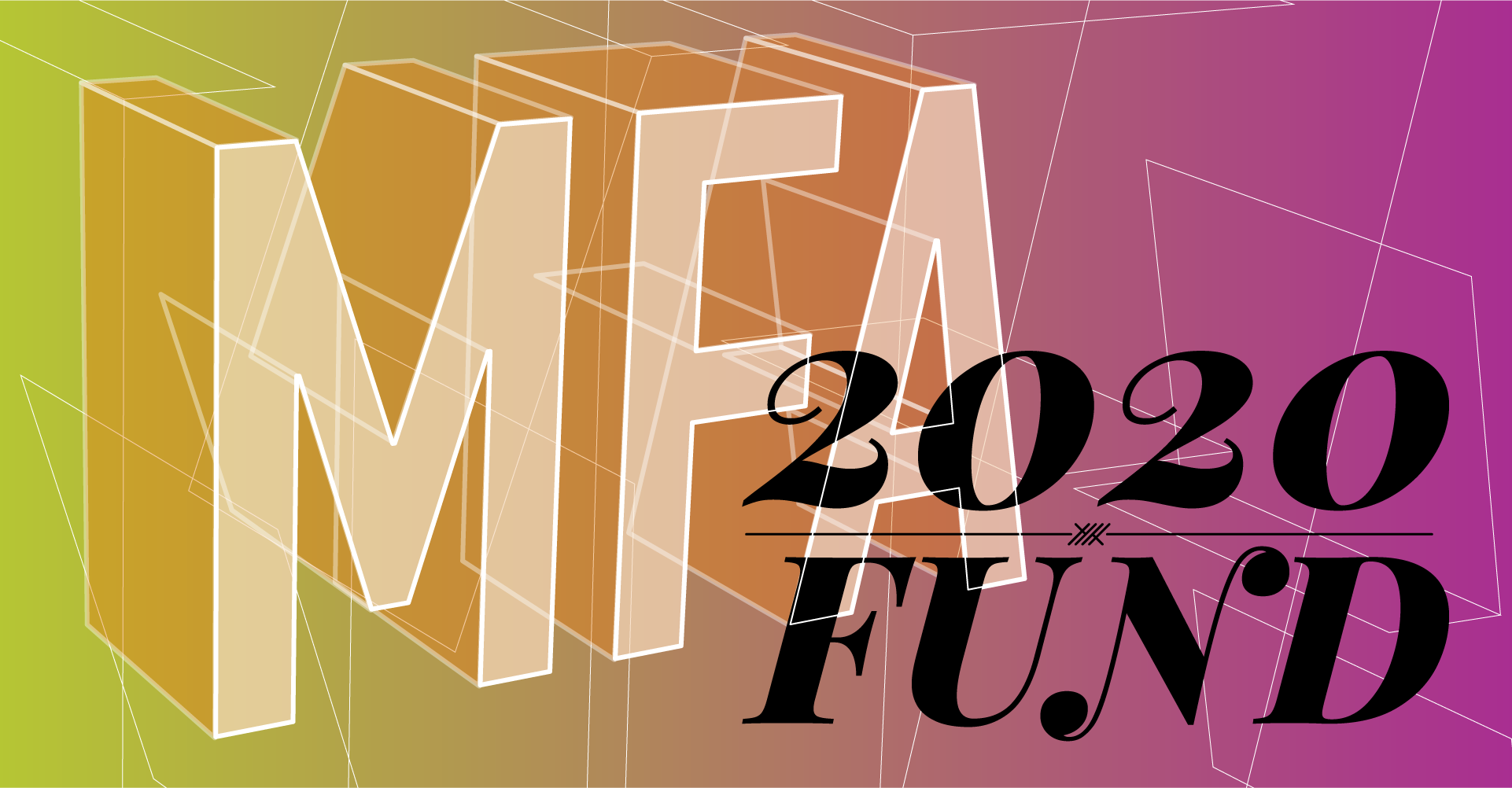FAQ
FAQ – Frequently Asked Questions
What are the studio spaces like?
Each studio is roughly 135 square feet (~9’x15′), although the layout might be slightly different in each one (see images in video above, or view this Open Studios tour). There is both florescent and incandescent lighting in each studio with individual controls. Studios are semi-private, which means they don’t have doors on each space, but students will often hang a curtain if they desire more privacy. Every studio is equipped with a table, chair, and cabinet, and MCAD’s Facilities team will help you locate furniture pieces if you need to swap one out for a different size or height, etc. We also have easels available for those who need them, and students often trade furniture to find the right combination. The basement studios have garden-level windows and an exhaust system to allow oil painters to work with solvents.
Can I work full time and do this MFA Program?
We support the prospect of students working while they are enrolled in the program, but we know from experience that it’s really hard to get the full benefit of the MFA program when you are working full-time. We would recommend working full-time for a few years to accumulate savings enough so you can afford to work only part-time while enrolled in the program. This is because having enough studio time is really important for making progress in your creative practice, mentorship, and classes. With a full-time job, it is extremely difficult to reserve much studio time to achieve your goals. To help visualize the time commitment, we’ve uploaded this sample schedule of an MFA student.
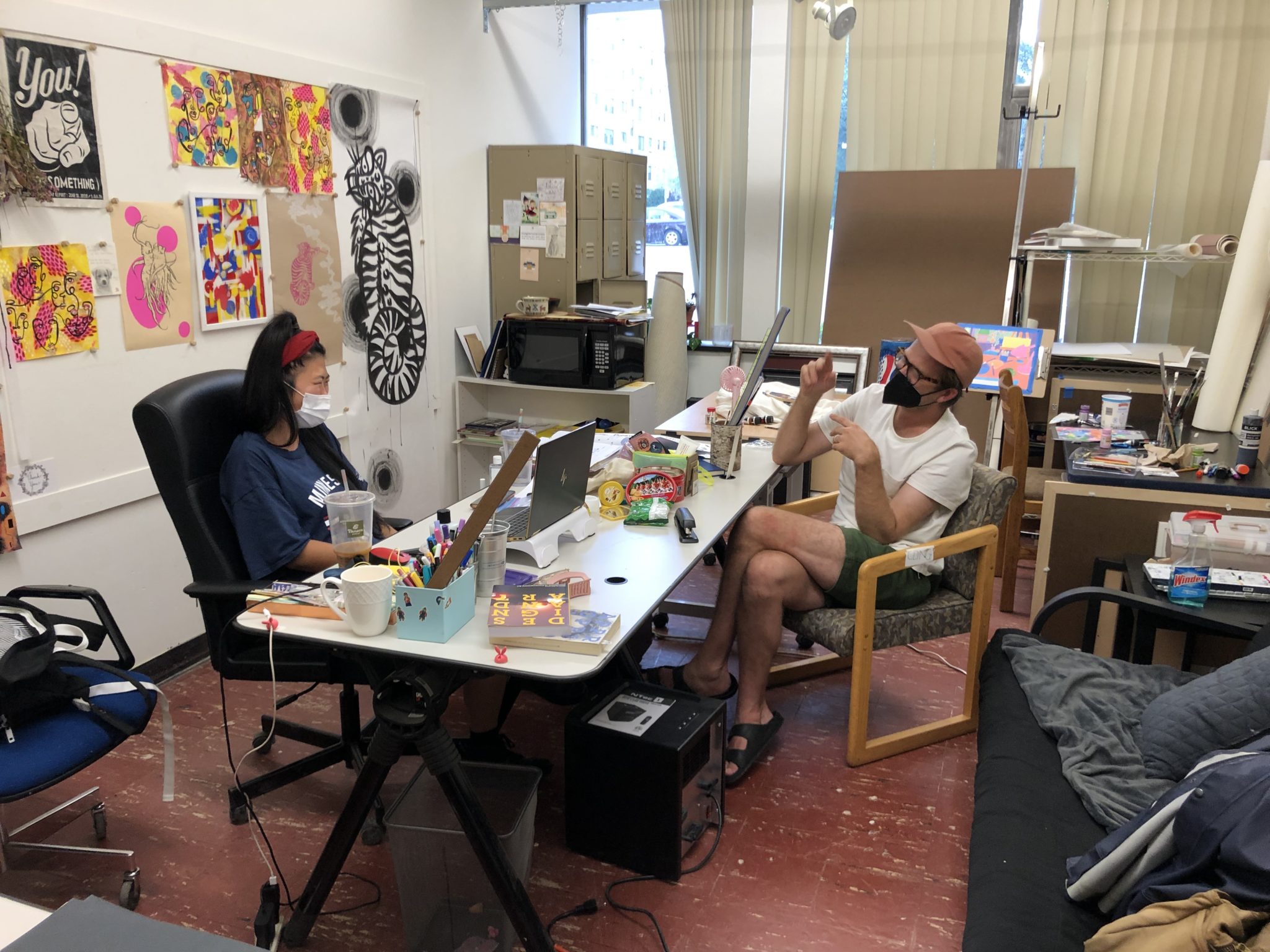
Bo Young An ’22 with Mentor Sam Kalda
How much time does the Graduate Assistantship take up?
Currently, the $6000 graduate assistantship (GA/GTA) is paid at the Minneapolis minimum wage of $15.19/hour (going up to $15.57/hour on Jan 1, 2024), and takes approximately 10-12 hours per week depending on which week you start in August and if you do assistantship hours over winter break. To help visualize the time commitment, we’ve uploaded this sample schedule of an MFA student.
Can I decline the Graduate Assistantship?
Yes, every year we have a few students who decline the $6000 graduate assistantship (GA/GTA) because they have a more lucrative part-time job outside of MCAD, and/or they don’t need or desire the experiences that the GA or GTA offers. There is no penalty for declining the assistantship.
Can I do the MFA Program part-time?
To be eligible for MCAD grants and assistantships, students must be full-time (at least 12 credits per semester). Students can retain their federal loans if they choose to attend part-time for a few semesters, but they would want to talk about that course planning with the MFA director to address any concerns. You can view our course grid for planning. Please note that the classes listed in semesters 1 and 3 occur only in the fall, and the classes listed in semesters 2 and 4 occur only in the spring.
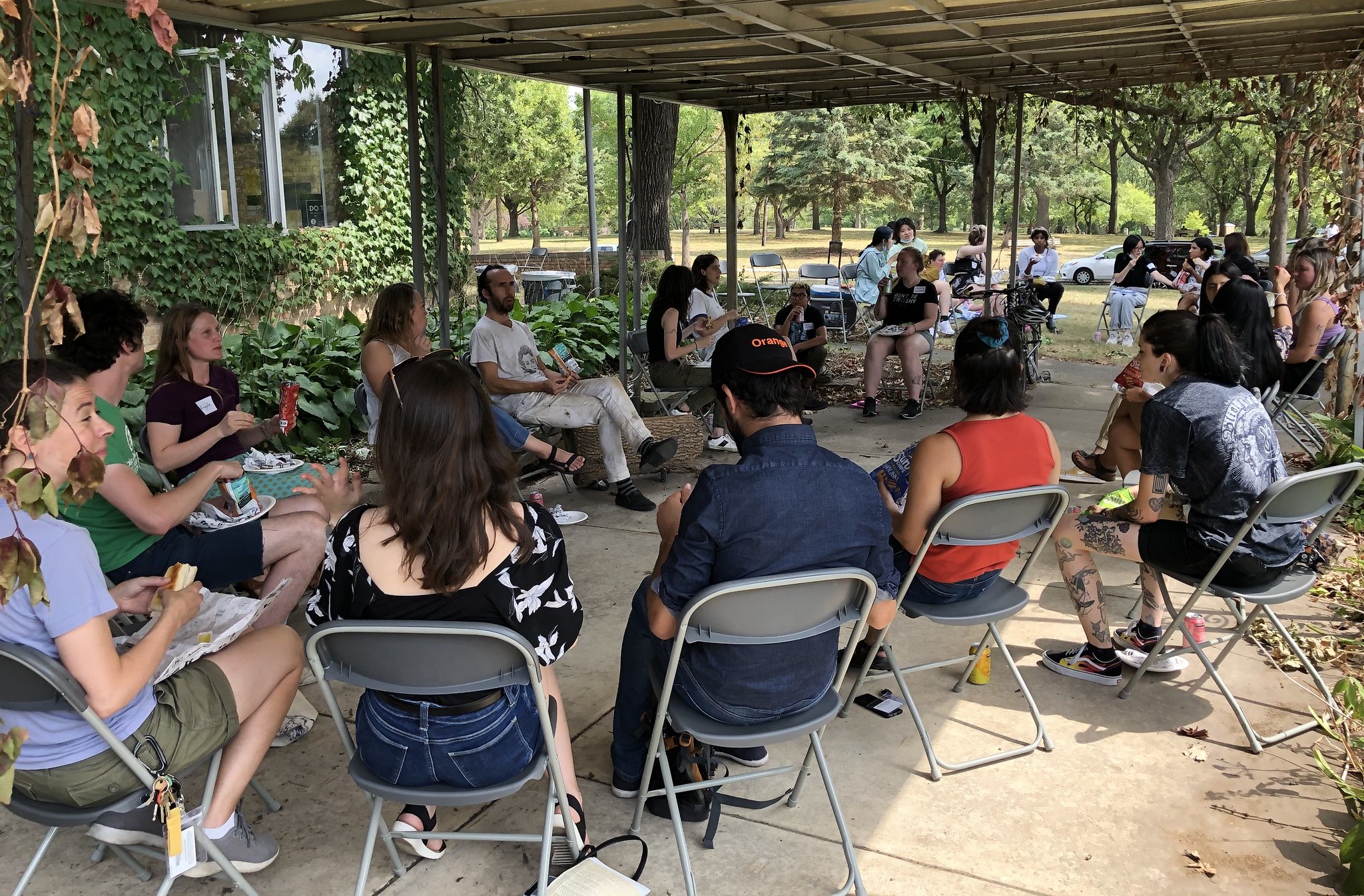
Orientation Luncheon Fall 2021
Do you recommend going to graduate school right after undergrad?
At any given time, about ¼ of our MFA students come directly from undergraduate studies, succeed, and we celebrate them! However, we generally recommend taking some time off between undergraduate and graduate study. Taking a break allows you to make at least one body of work that is driven by your own interests rather than the structures of academic assignments or capstone projects. Additionally, taking some time off will help you focus and articulate exactly why you want to return to an MFA program. Lastly, working for a while after undergraduate studies can help you save up funds and reduce the amount of loans you might need to take out to support your studies.
What skills/qualities will help you succeed?
It is important that you are able to be self-driven and organized to execute all the goals you will set, both short term and long term. Time-management is a necessary skill.
The program emphasizes engagement in deep discussions around select topics, critical reading and writing skills and some scholarly research, and professional presentation skills. While you might not have all those skills before starting grad school, you must be willing to develop them while you are here. It’s important to have a willingness to work hard in the face of difficulty – grad school can be very challenging – as well as a general attitude of experimentation and open-mindedness as you wrestle with new ideas.
Also, it is useful to be comfortable working on an idea or concept over time, through a series, or as an expansive project. We push students to experiment and try new approaches to their concepts, which often results in a series of related works. We are always excited to see grad school applications that demonstrate examination of a theme(s) over time and through a number of pieces or experiences.
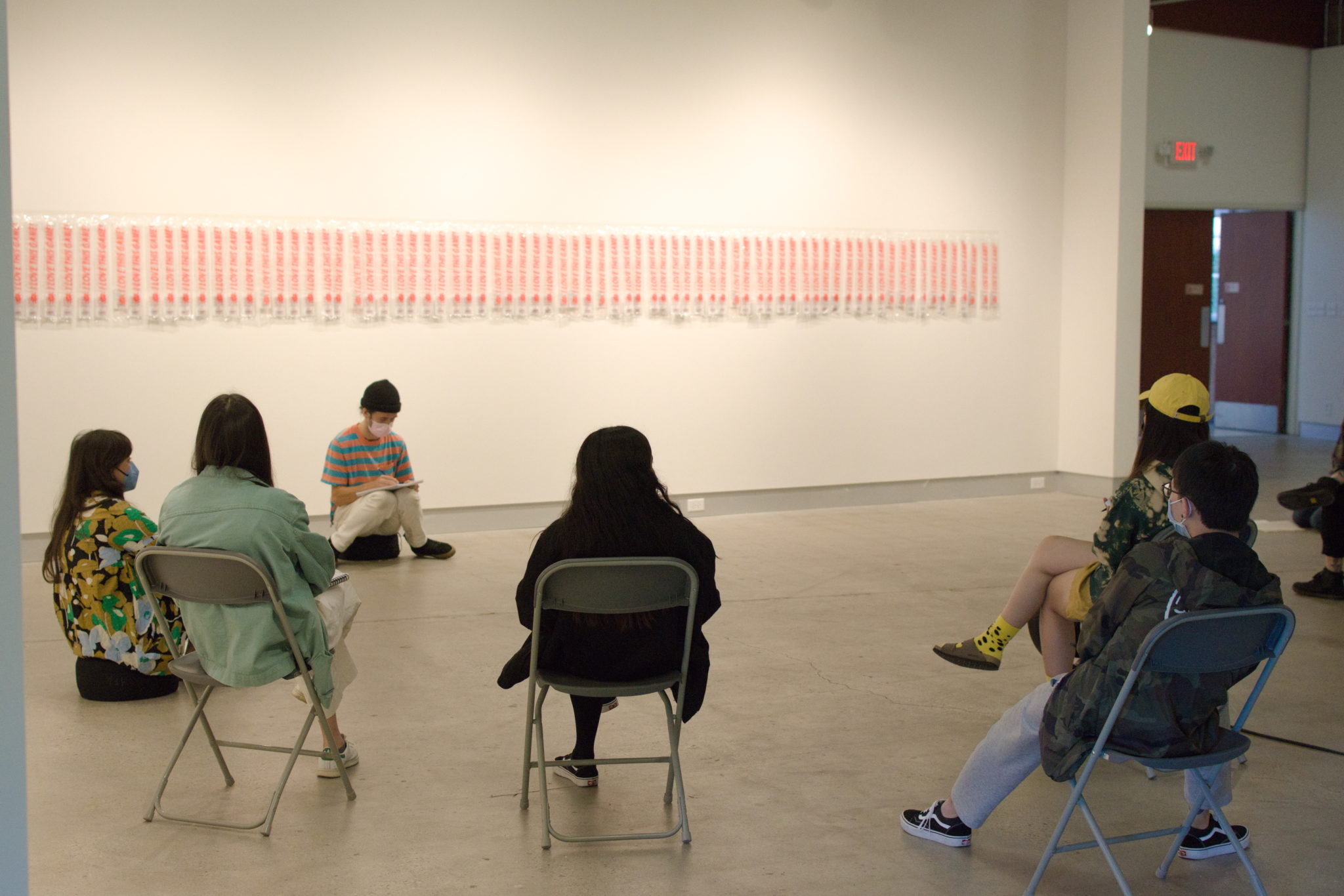
Graduate Critique Seminar 1
Will there be other people studying my medium/media?
It depends. Sometimes there are multiple students studying in the same medium, but other times you might be the only person studying a particular mode of working. It varies year to year, and this is partly why it is helpful to be self-driven. The interdisciplinary environment of the program asks our graduate students to question their work and the medium(s) they work with. It is not uncommon for students to experiment and work with new mediums and modes of working during their time in the program. We celebrate this risk taking and experimentation, and the doors it opens for our students in collaboration, developing conceptual strategies, and inventing their own hybridized forms of art making.
While we value and celebrate our interdisciplinary program and courses where everyone provides feedback on all types of work, we also recognize that students might also want to join media-specific conversations. In that case, we direct students to audit undergraduate courses in their medium, or join community-based organizations, so they can connect with media-specific discourse. Students also have media-specific conversations with their mentor on a weekly basis, and engage with media-specific studio visits.
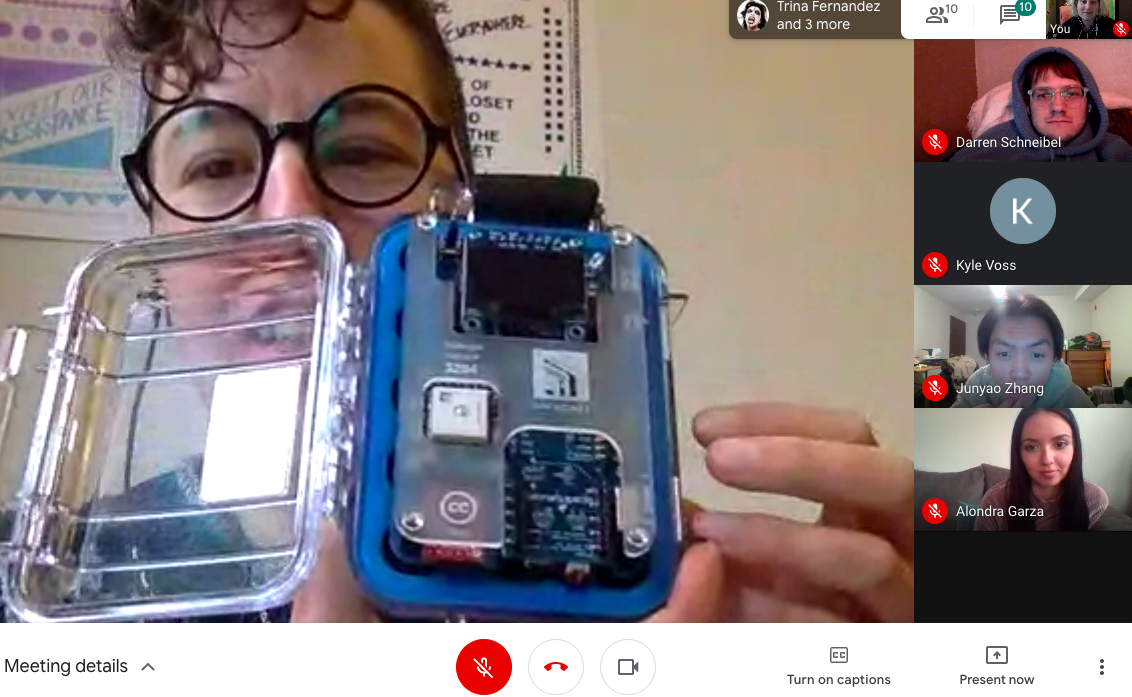
Kelley Meister ’08 visits Graduate Critique Seminar, Spring 2020
What are your job placement statistics?
Job placement information from alumni who responded – not all alumni submitted (Aggregate from 2010-2019 [per our Alumni Survey, which is the instrument that goes back that far]):
60% reported working full-time or working full-time and freelancing
25% reported working part-time and freelancing
Are these spaces historically coded as white, or is MCAD a PWI?
Yes, like many institutions of higher ed, MCAD has historically been coded as white, also known as a “Predominantly White Institution” (PWI), meaning it is an institution of higher learning in which white people account for 50% or greater of the student enrollment. In acknowledgement of this fact, the MFA Program and MCAD are continuously working to address systemic racism and equity issues. Our community agreements and priorities speak to these efforts and goes into further detail on our aim to create a collective, equitable, inclusive, and accessible community for an interdisciplinary and diverse group of makers. Additionally, all our faculty are asked to reflect on the curriculum by analyzing course materials for diverse representation.
Much has been written about the challenges Black, Indigenous, and people of color face at MFA Programs at PWI (both writing and art/design programs). This 2019 article poses good questions about preparing for MFA Programs as a person of color (it has a writing focus, but poses universal questions). This 2015 article traces various challenges via a group conversation from a low-residency writing MFA program in North Carolina, and is in response to this 2014 article by Junot Diaz. There are also many non-art/design resources out there to check out, such as the Black In Grad School podcast.
Housing
Most MFA students live off-campus. We have put together this Housing page, which lists some local rental companies MFA alumni have rented from. On-campus housing is available to international MFA students first, and on a space-available basis for domestic MFA students. Here are some additional images of MCAD housing.
Curriculum/ Coursework
To check out our curriculum and courses, please visit this page, which is kept up-to-date.
Electives
To review our current elective courses, please visit this page. Electives are listed towards the end of the page.
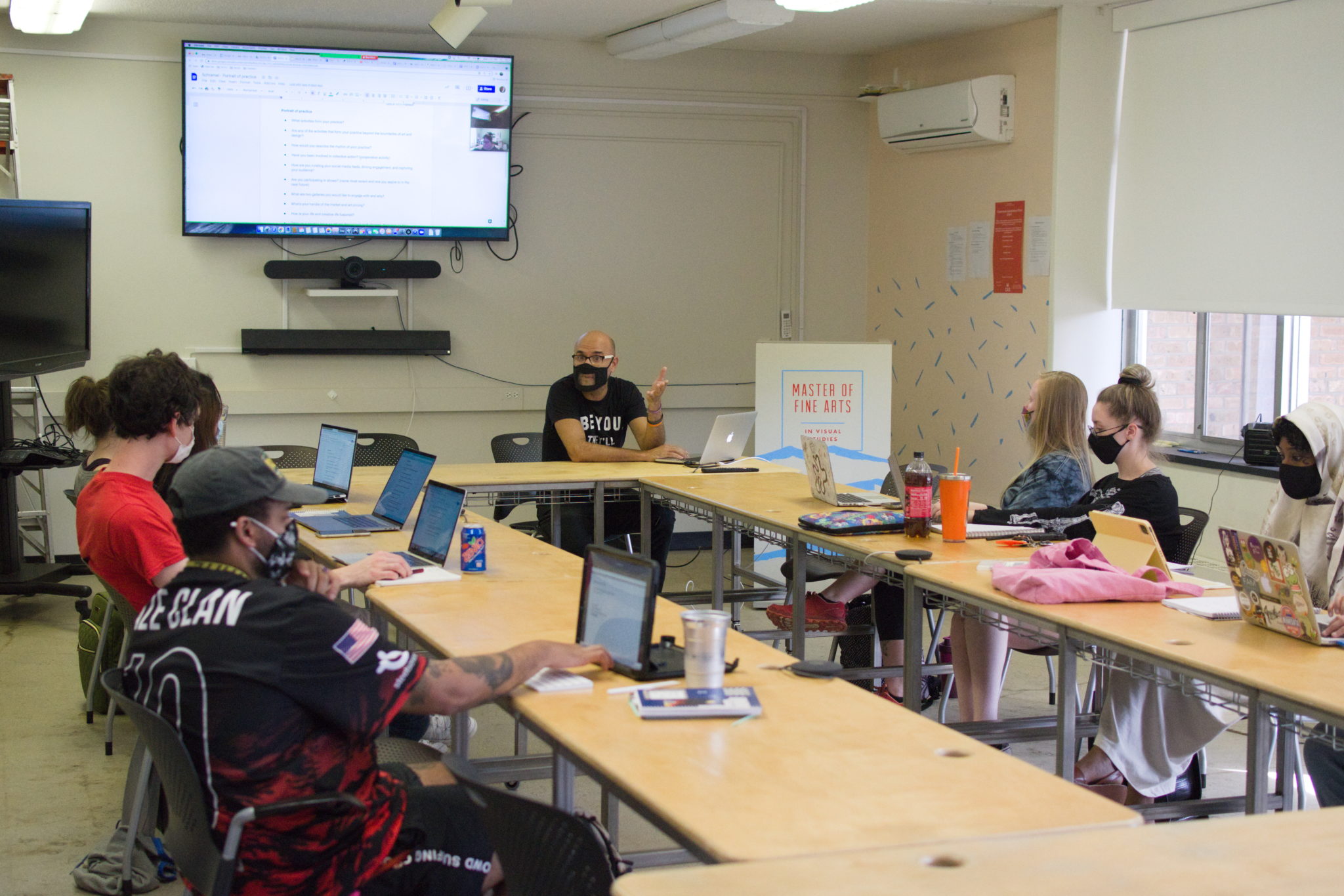
Criticism and Theory 1 with Billy Franklin
Mentorship Model
Mentorship is regarded as the core of the MCAD MFA curriculum. We have detailed information about the process of selecting and working with a mentor in our Mentor/Mentee Handbooks, which are available for download on the MFA Intranet Page.
Mentorship is structured to facilitate discussions and assess goals on a weekly basis. Students work one-on-one with their mentor for the advancement of studio work, research, and professional practice. Each semester the student and mentor determine the mentorship’s content, which is summarized in a “Semester Learning Contract” in context with the student’s “Long-Range Learning Plan.”
Students can expect to spend approximately one hour per week with their mentor (or equivalent). Mentorship can include attending visiting artist/designer lectures together or separately, exhibitions and workshops, audited courses, seminars, and internship opportunities.
We draw on not only the exceptional faculty at MCAD, but also the concentrated expertise of the Twin Cities’ artists, designers, curators, and critics to find mentors uniquely suited to students’ personal goals, practices, and research methods. We also now allow virtual mentorship, so we are not limited by geography. This list of recent mentors helps students look at some of the people available for mentorship.
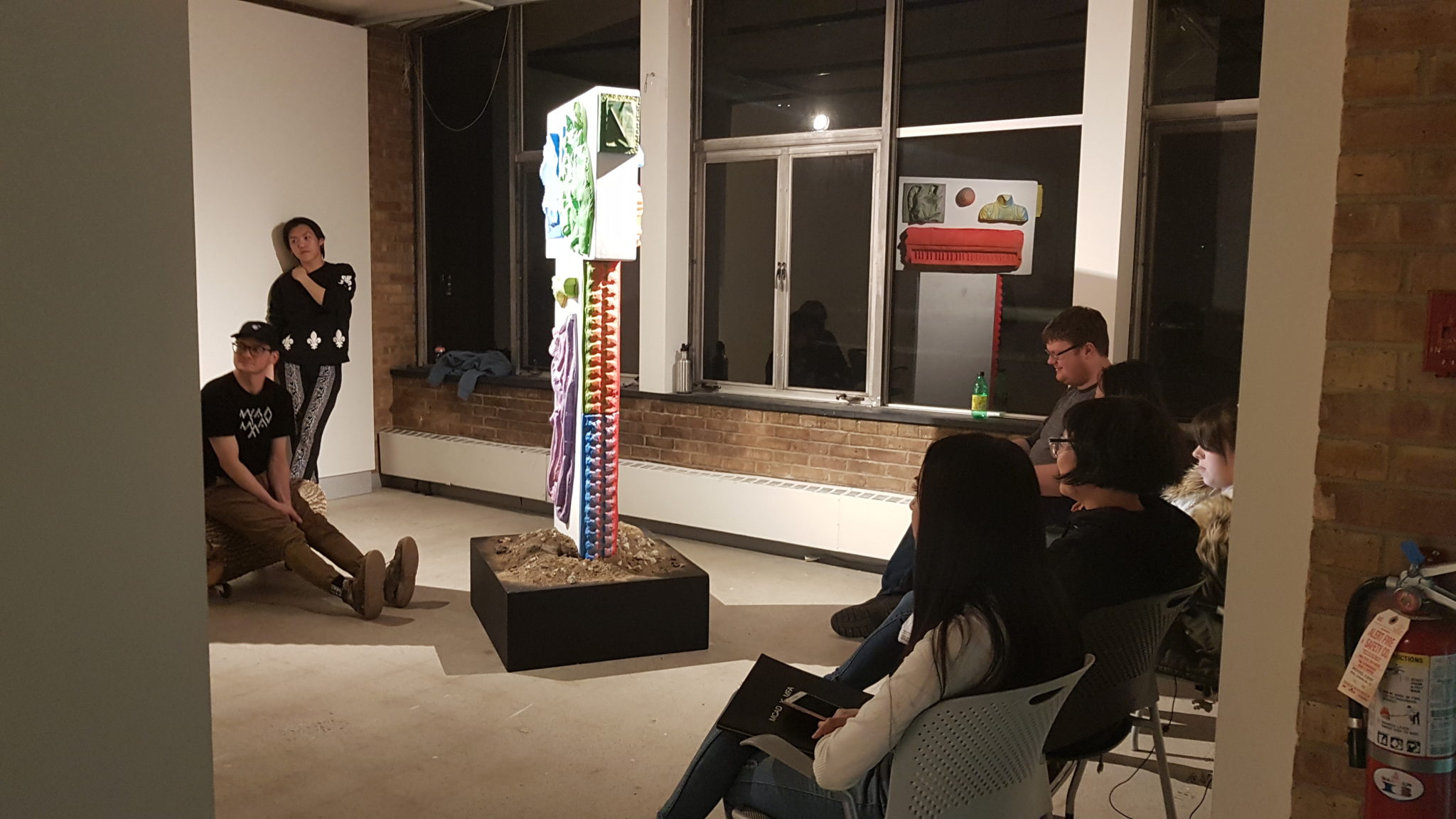
Darren Schneibel ’21 during Graduate Critique Seminar
Professional Practices and Career Development
Making sure our graduates have what they need to succeed after graduation is a central concern of the MCAD MFA Program.
Launch Programming
With a special emphasis on networking and CV-building, these pivotal funded programs help our MFA students set themselves up for success after graduation. Opportunities range across galleries, residencies, art centers, design agencies, and various non-profits. Read about all our Launch Programs and see a record of recent recipients.
Professional Practices Workshops
Each semester, we host a series of talks/workshops focused on professional practices (alumni are invited to attend, and we feature alumni as speakers when possible). Topics range widely and are selected based on current student interests and suggestions.
Career Development Services
MCAD offers a comprehensive career development office, where you can make an appointment for résumé and cover letter help, or to work on interviewing and networking skills. MCAD also offers the Job and Internship Fair, the Emerging Talent Showcase, and the Annual Art Sale. And as an MCAD alumnus, you’ll have ongoing access to these resources and services.
Online Resources
MCAD students have free access to LinkedIn Learning while they are enrolled. This includes self-paced courses like Writing a Cover Letter, Expert Tips for Answering Common Interview Questions, and Successful Networking (among many others). We also recommend checking out ImaginePhD (career planning), and various online conferences, such as the free events with Beyond Professoriate, Grad School Summit, and Beyond Academia.
Teacher Training and Support
We have a series of classes and experiences to help our MFA students acquire teaching skills that can be applied in a number of different contexts. For those interested in teaching specifically in higher education, we need to acknowledge that it is increasingly difficult to secure full-time teaching positions due to a variety of factors. To learn more, please read The Professor Is In by Dr. Karen Kelsky, which goes into detail about the current higher ed job market, and the work required to possibly secure a full-time position in academia.
Art on Campus
MCAD has several spaces on campus where MFA students can apply to exhibit their work. This includes Gallery 148, the Suitcase Gallery, the Black Box (main campus, 3rd floor), and the Library Gallery. The Main Gallery also showcases the annual Made at MCAD juried exhibition.
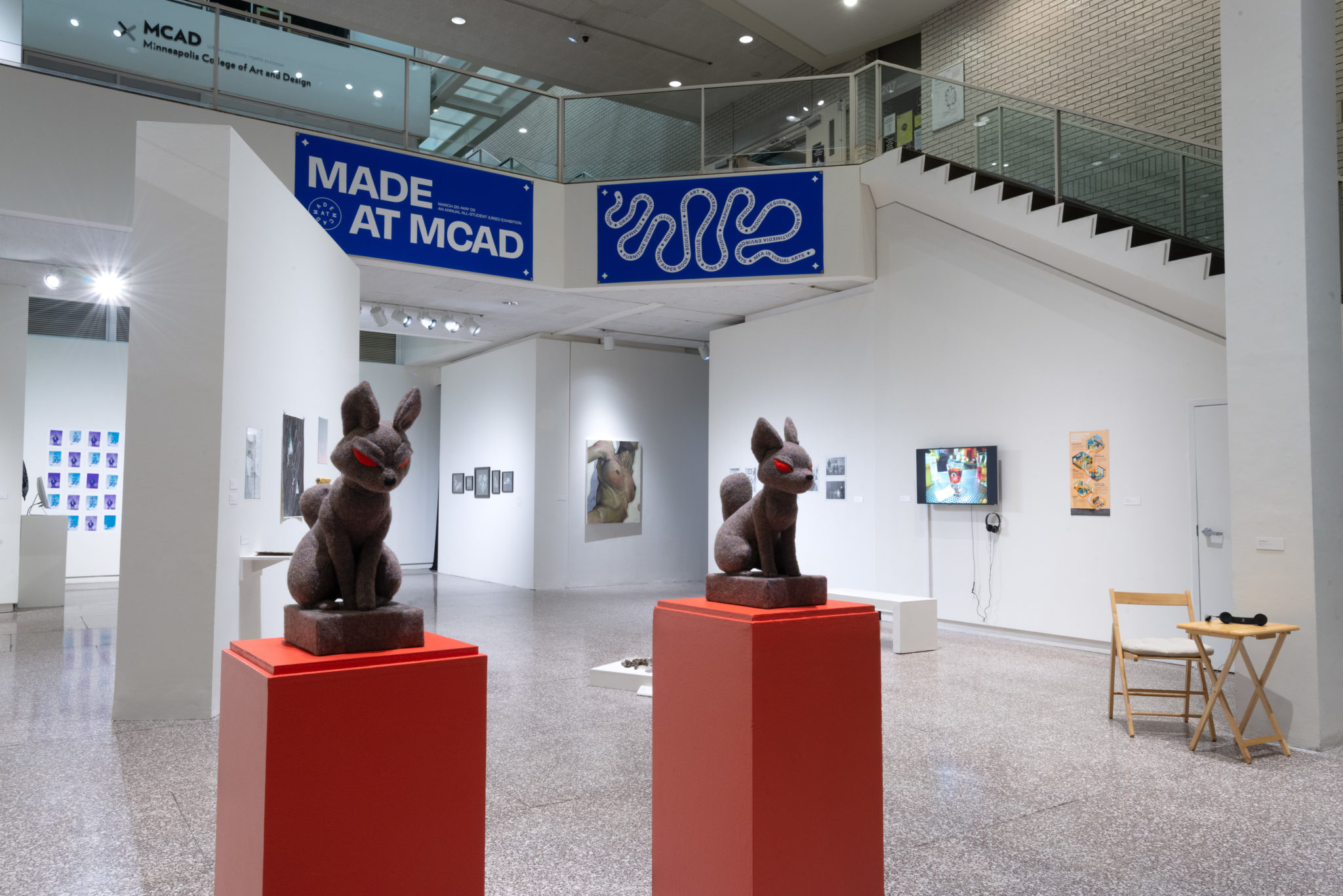
Jocelyn Suzuka ’21 in the Spring 2021 Made at MCAD exhibition
Student Life
MFA students are often fairly focused on their studio practice and studies, but that doesn’t mean they can’t take advantage of all the student groups MCAD has to offer. MCAD student clubs, are a great way to expand your social circle. We especially want to highlight those clubs with identity foci, which help connect and support various communities on campus. Many of these clubs are majority undergraduates, which helps to further integrate MFA students with the undergrads.
At the start of fall 2020 semester, the following clubs were active: Black Artist Student Union, Latinx Unidas, Jewish Cultural Club, Quellective, Disabled Student Union, Anime Club, Music Club, Bee Club, Zelda Fanclub, Comics Club, Video Game Club, Animation Study Group, Kahoot Club (fka boardgame club), Gardening and Plant Care Club, WYC (Wheel of the Year Club), and Lo-Fi Movie Club.
Life in the Twin Cities
MCAD is located in the Whittier Neighborhood, and you can learn more about the shops, restaurants (we’re a block away from Eat Street), and attractions in our area at On The Grid. Another great resource on all things Minnesota is Minnevangelist. Read more about selected local museums, organizations, and events on our About page.
We also assembled a map of Black-Owned Restaurants (compiled from a variety of local news sources) within a 3-mile radius of MCAD to allow for walking / biking access. Many of our current students and alumni have been interested in a variety of mutual aid efforts, and dining locally (especially take-out) is a great way to support our local Black community.
Alumni Benefits
View this full list of perks just for MCAD MFA alumni. Find a complete list of the benefits all MCAD alumni enjoy at mcad.edu/alumni-benefits Also, no matter where you go in the world, connect with your classmates, network with other alumni in your area, and be a resource for current students. There are several Facebook alumni groups, and there is a LinkedIn Group for MCAD Alumni.


